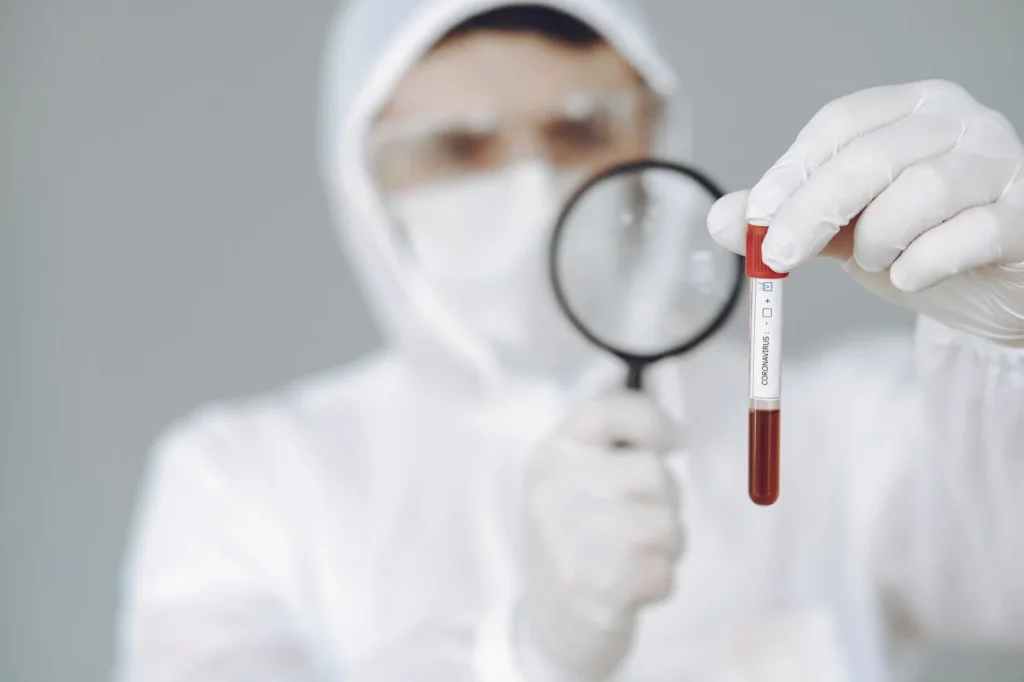Table of Contents:
- Introduction
- What Are Bloodborne Pathogens?
- Transmission of BloodBorne Pathogens
- Steps To Prevent Transmission of Bloodborne Pathogens
- Final Words
Introduction
Bloodborne pathogens, also known as harmful microorganisms, are a threat to serious infections such as HIV, hepatitis B (HBV), and hepatitis C (HCV).
In the U.S. alone, approximately 40,000 new HIV cases emerge each year, and according to the Centers for Disease Control and Prevention (CDC), about 25% of those infected are unaware they have the virus. These statistics demonstrate the slow but highly damaging effects of pathogens, especially in professions like healthcare and public safety.
In this blog, we will explore how bloodborne pathogens are spread and the preventive measures to stop the infection.
What Are Bloodborne Pathogens?
Bloodborne pathogens are disease-causing microorganisms, living in the bloodstream and other body fluids. It spreads through infected blood, needles, or open wounds, causing severe infections, including the hepatitis B virus (HBV), hepatitis C virus (HCV), and human immunodeficiency virus (HIV). Let’s briefly examine them:
Hepatitis B and Hepatitis C Virus
Hepatitis B and hepatitis C viruses are known to attack the liver, causing severe liver damage. While hepatitis B can survive outside the body in dried blood for up to seven days, hepatitis C often leads to a long-term infection that can cause chronic liver disease. These viruses are a significant concern, especially for individuals such as housekeepers and laundry personnel who may unknowingly come into contact with infected blood in non-medical settings.
Unfortunately, by the time symptoms become visible, the viruses may have already caused significant liver damage. Hepatitis B can sometimes resolve on its own, but hepatitis C often leads to chronic infections that require long-term treatment.
HIV (Human Immunodeficiency Virus)
HIV, the virus responsible for causing AIDS, is another major bloodborne pathogen. Once a person is infected with HIV, the virus gradually weakens the immune system, making the body more susceptible to infections that would normally be harmless.
AIDS, the final stage of HIV infection, occurs when the immune system becomes severely compromised. Without treatment, most people with HIV eventually die from infections due to their weakened immune systems. Although there is no cure for HIV, medical treatments have significantly improved over the years, allowing infected individuals to live longer and healthier lives.
Hepatitis and HIV Symptoms
Hepatitis B, Hepatitis C, and HIV share common symptoms. However, they often go unnoticed in their early stages, making it difficult to detect an infection right away. Let’s briefly go through the symptoms in below table:
| Disease | Symptoms | Onset of Symptoms After Exposure |
| Hepatitis B | Mild to no symptoms. Symptoms may include fatigue, jaundice, abdominal pain, and dark urine. | 8 weeks to 5 months |
| Hepatitis C | Many people show no symptoms. When symptoms occur, it include fatigue, joint pain, nausea, and jaundice. | 8 weeks to 5 months |
| HIV | Early symptoms resemble flu-like illness. As the virus progresses, it weakens the immune system, leading to infections and illnesses. | It can take years for severe symptoms (AIDS) to develop |
Transmission of BloodBorne Pathogens
Bloodborne pathogens transmission is most common in workplaces, especially in healthcare settings, laboratories, or environments where exposure to blood and bodily fluids is possible. There are several modes of transmission for bloodborne pathogens, including:
Direct Contact
Transmission occurs when infected blood or bodily fluids enter another person’s body through open wounds, cuts, acne, blisters, or sunburns. For example, this can happen if blood splashes into someone’s eyes or onto an open wound. Unprotected sex with an infected person, particularly in the case of HIV, and sharing hypodermic needles also transmit bloodborne pathogens. Additionally, these pathogens can be passed from an infected mother to her child during childbirth or through breastfeeding.
Indirect Contact
Indirect transmission happens when someone touches a surface or object contaminated with infected blood, such as needles, which then comes into contact with mucous membranes (like the eyes, nose, or mouth). Sharp objects such as needles or broken glass that puncture the skin pose a significant risk, especially for healthcare workers or lab personnel.
Respiratory Droplet Transmission
Although less common with bloodborne pathogens, transmission can occur when someone inhales droplets from an infected individual, typically through sneezing or coughing.
Vector-Borne Transmission
In this form of transmission, a pathogen is spread through the bite or sting of an insect carrying the infection, though this is rare with bloodborne pathogens like HBV or HIV.
Body Fluids Involved in Transmission
Bloodborne pathogens are not limited to transmission through blood alone. Several other body fluids can also carry these infectious agents, making them potential sources of infection. It is essential for anyone working in healthcare or other fields where chances of exposure to bodily fluids are common. These include:
- Semen and vaginal secretions
- Amniotic fluid
- Synovial fluid (fluid in the joints)
- Pleural fluid (fluid in the lungs)
- Saliva, particularly during dental procedures
Steps to Prevent Transmission of Bloodborne Pathogens
Preventing the transmission of bloodborne pathogens requires proper precautions and adherence to protective guidelines. Healthcare workers should receive bloodborne pathogen training to learn essential protective measures. Here are several steps you can take to reduce the risk of infection:
- Personal Protective Equipment (PPE): Always wear appropriate protective gear, such as gloves, gowns, masks, and eye protection, to create a barrier between yourself and potentially infected materials.
- Safe Needle Practices: Use safe needle devices to reduce the risk of accidental punctures. Avoid bending or recapping needles after use, and dispose of them in designated sharps containers.
- Proper Disposal of Sharps and Waste: Dispose of needles and sharp objects in puncture-resistant containers. Soiled materials and gloves should be discarded in biohazard bags.
- Use of Biohazard Bags: Place all contaminated items, including gloves and bandages, in biohazard bags marked with proper warning labels.
- Sharps Disposal: Always use puncture-resistant containers for sharp objects and needles to prevent injury.
- Disinfect Work Areas: Clean and disinfect any surface or equipment that has been exposed to blood or body fluids. A solution of one part bleach to ten parts water is effective for this.
Safeguarding Your Employees
Bloodborne infections are a serious threat, particularly in healthcare settings. Protecting yourself from the transmission of bloodborne pathogens requires strict adherence to standard precautions and implementing an exposure control plan.
This is especially important since certain bloodborne pathogens, such as HIV, have no cure, and others, like HBV, may not always be preventable by vaccination.
Following correct standards, such as the use of protective equipment, safe disposal methods, and hygiene measures, can significantly reduce the risk of unintentional exposure to bloodborne pathogens.







